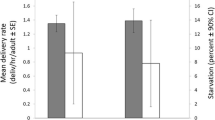Abstract
Behaviorally dominant members of blue-footed booby (Sula nebouxii) broods can effect siblicide by restricting access of subordinate siblings to parents providing food. In spite of their capacity for siblicide, dominant chicks permit subordinates to feed during short-term food shortage; in fact, the proportion of the food that the dominant takes is independent of the total amount delivered in older chicks. A model of optimal food distribution suggests that dominant chicks maximize their inclusive fitness with this pattern, rather than by satisfying their own food requirements and leaving what remains for the subordinate sibling. The indirect reproductive potential represented by a chick's sibling appears to have influenced the evolution of siblicidal brood reduction in this species.
Similar content being viewed by others
References
Anderson DJ (1989a) The role of hatching asynchrony in siblicidal brood reduction of two booby species. Behav Ecol Sociobiol 25:363–368
Anderson DJ (1989b) Differential responses of boobies and other seabirds in the Galápagos to the 1986–87 El Niño-Southern Oscillation event. Mar Ecol Prog Ser 52:209–216
Anderson DJ (1989c) Ecology and behavior of siblicide in masked and blue-footed boobies (Sula spp). Ph.D. dissertation, University of Pennsylvania, Philadelphia
Anderson DJ (1990a) Evolution of obligate siblicide in boobies. 1. A test of the insurance egg hypothesis. Am Nat 135:334–350
Anderson DJ (1990b) Evolution of obligate siblicide in boobies.2. Food limitation and parent-offspring conflict. Evolution 44:2069–2082
Anderson DJ, Ricklefs RE (1987) Radio-tracking masked and blue-footed boobies in the Galapagos Islands. Nat Geog Res 3:152–163
Anderson DJ, Ricklefs RE (1992) Brood size and food provisioning in masked and blue-footed boobies (Sula spp.). Ecology 73:1363–1374
Brown JL (1987) Helping and communal breeding in birds. Princeton University Press, Princeton
Cash KJ, Evans RM (1986) Brood reduction in the American white pelican (Pelecanus erythrorhynchos). Behav Ecol Sociobiol 18:413–418
Clark AB, Wilson DS (1981) Avian breeding adaptations: hatching asynchrony, brood reduction, and nest failure. Q Rev Biol 56:253–277
Dawkins R (1976) The selfish gene. Oxford University Press, Oxford
Drummond H (1987) A review of parent-offspring conflict and brood reduction in the Pelecaniformes. Colon Waterbirds 10:1–15
Drummond H, Gonzalez E, Osorno J-L (1986) Parent-offspring cooperation in the blue-footed booby (Sula nebouxii): social roles in infanticidal brood reduction. Behav Ecol Sociobiol 19:365–372
Drummond H, Garcia Chavelas C (1989) Food shortage influences sibling aggression in the blue-footed booby. Anim Behav 37:806–819
Forbes LS (1990) Insurance offspring and the evolution of avian clutch size. J Theor Biol 147:345–359
Forbes LS (1993) Avian brood reduction and parent-offspring “conflict”. Am Nat 142:82–117
Hahn DC (1981). Asynchronous hatching in the laughing gull: cutting losses and reducing rivalry. Anim Behav 29:421–427
Hamilton WD (1964) The genetical theory of social behaviour: I, II. J Theor Biol 7:1–52
Hussell DJT (1972) Factors affecting clutch size in Arctic passerines. Ecol Monogr 42:317–364
Hussell DJT (1985) On the adaptive basis for hatching asynchrony: brood reduction, nest failure and asynchronous hatching in snow buntings. Ornis Scand 16:205–212
Lack D (1954) The natural regulation of animal numbers. Clarendon, Oxford
Lack D (1968) Ecological adaptations for breeding in birds. Chapman and Hall, London
Magrath RD (1988) Hatching asynchrony in altricial birds: nest failure and adult survivorship. Am Nat 131:893–900
Mangel M, Clark CW (1988) Dynamic modelling in behavioral ecology. Princeton University Press, Princeton
McGinley MA, Temme DH, Geber MA (1987) Parental investment in offspring in variable environments: theoretical and empirical considerations. Am Nat 130:370–398
Mock DW (1984) Infanticide, siblicide, and avian nesting mortality. In: Hausfater G, Hrdy SB (eds), Infanticide: comparative and evolutionary perspectives. Aldine, New York, pp 3–30
Mock DW, Drummond H, Stinson CH (1990) Avian Sibilicide. Am Sci 78:438–449
Nelson JB (1978) The Sulidae. Oxford University Press, Oxford
O'Connor RJ (1978) Brood reduction in birds: selection for infanticide, fratricide, and suicide? Anim Behav 26:79–96
Parker GA, Mock DW, Lamey TC (1989) How selfish should stronger sibs be? Am Nat 133:846–868
Ricklefs RE (1984) Meal sizes and feeding rates of Christmas shearwaters and Phoenix petrels on Christmas Island, central Pacific Ocean. Ornis Scand 15:16–22
Smith CC, Fretwell SD (1974) The optimal balance between size and number of offspring. Am Nat 108:499–506
Trivers RL (1974) Parent-offspring conflict. Am Zool 14:249–264
Author information
Authors and Affiliations
Additional information
Communicated by G. Wilkinson
Rights and permissions
About this article
Cite this article
Anderson, D.J., Ricklefs, R.E. Evidence of kin-selected tolerance by nestlings in a siblicidal bird. Behav Ecol Sociobiol 37, 163–168 (1995). https://doi.org/10.1007/BF00176713
Received:
Accepted:
Issue Date:
DOI: https://doi.org/10.1007/BF00176713




